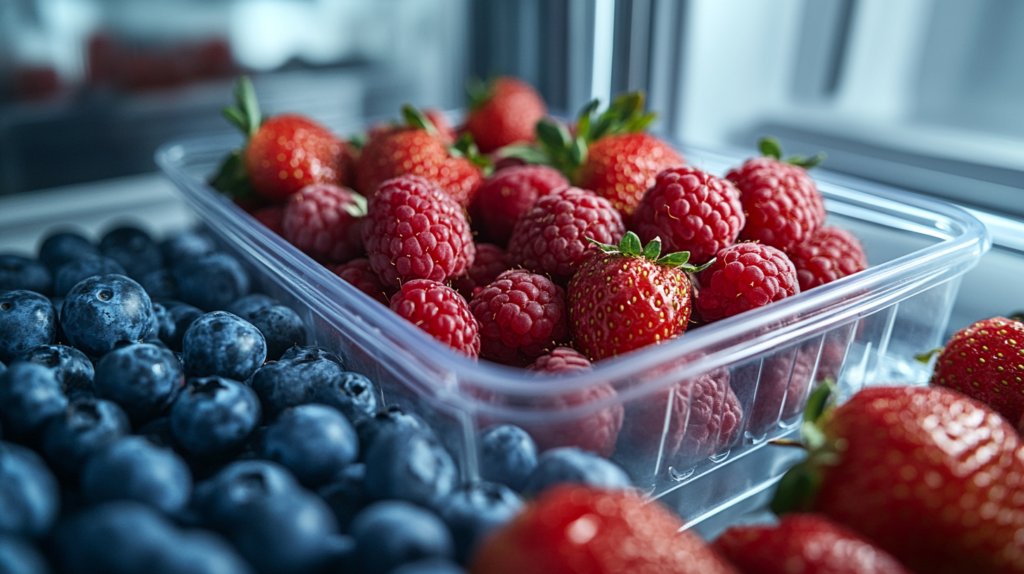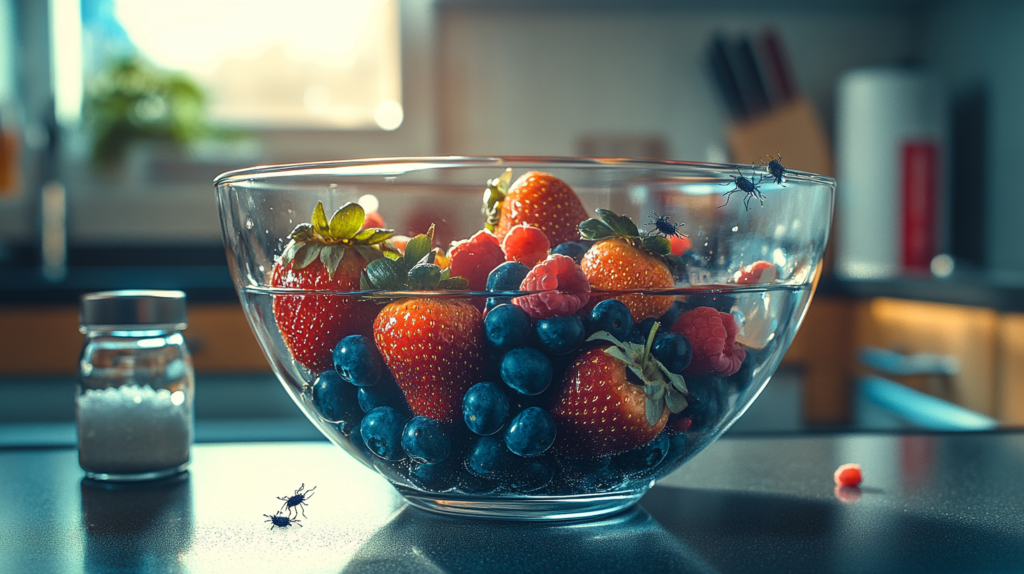Table of Contents
Introduction
Berries are nature’s sweet little treats, bursting with flavor and nutrients. From strawberries to blueberries and raspberries, these fruits are a staple in many diets. However, their delicate structure and natural environment make them prone to hosting tiny bugs, such as aphids, spider mites, and fruit flies. So, how do you get bugs out berries? Removing bugs effectively is crucial to ensure safe and enjoyable consumption. Whether you’re snacking on fresh berries, blending them into smoothies, or using them in recipes, knowing how to clean them properly is a must. This article provides a comprehensive guide on how to remove bugs from berries, using natural methods and preventive measures to keep them bug-free.
Common Types of Bugs in Berries
Identifying the Most Common Pests
Berries attract a variety of pests, especially during their growing stages. Some of the most common bugs found in berries include:
- Aphids: Tiny, pear-shaped insects that often cling to the undersides of leaves or hide in clusters of berries.
- Fruit Flies: Small, fast-moving flies that are drawn to overripe berries and sugary residues.
- Spider Mites: Microscopic bugs that leave fine webbing on plants and berries.
- Thrips: Slender insects that feed on the juice of berries, often leaving discoloration or scars.
- Beetles: Larger pests that may burrow into berries, leaving visible holes.
Signs of Bug Infestation
- Sticky residue or sugary spots on berries.
- Visible bugs or small larvae clinging to the fruit.
- Tiny holes or scars on the surface of the berries.
- Presence of fine webbing or unusual discoloration.
Understanding the types of pests you’re dealing with helps tailor the cleaning process to ensure thorough bug removal.
How to Spot Bug-Free Berries at the Market
Choosing bug-free berries starts at the point of purchase. By carefully inspecting your berries before buying them, you can avoid bringing home unwanted pests or damaged fruit.
Look for Signs of Freshness
Fresh berries are less likely to harbor bugs compared to overripe or damaged ones. Knowing what to look for can save you time and effort later.
Key Indicators of Freshness:
- Color: Vibrant, consistent colors with no discoloration.
- Texture: Firm berries with no soft spots or mushiness.
- Smell: A pleasant, fruity aroma rather than an overripe or fermented smell.
Inspect Packaging Thoroughly
When purchasing pre-packaged berries, carefully examine the container for potential signs of bugs or spoilage.
What to Check:
- Webbing or Larvae: Any visible webbing, especially in corners, may indicate pests.
- Moisture Build-Up: Condensation or sticky residues can signal that the berries are overripe or harbor bugs.
- Debris: Look for twigs, leaves, or soil, which may suggest inadequate cleaning during harvesting.
Avoid Bulk Containers
Bulk bins or open containers of berries can sometimes be more prone to contamination or pest activity. Opt for sealed or pre-packaged berries whenever possible for better quality control.
Buy Local or Organic Berries
While organic berries may sometimes attract more bugs, they are less likely to have pesticide residues. Buying local berries also ensures freshness, reducing the risk of spoilage during transport.
Tips for Choosing Organic:
- Inspect for any external signs of infestation.
- Ensure the berries are fresh and not overly ripe, as pests are more attracted to overripe fruits.
Why Choosing Clean Berries Matters
Purchasing bug-free berries minimizes the amount of cleaning required and reduces the risk of bringing pests into your home. While it’s still essential to clean all berries before consuming them, choosing wisely at the market simplifies the process.
Why Proper Bugs Removal from Berries Matters
Health Risks of Consuming Bugs
While most bugs found on berries are harmless, consuming them can lead to discomfort or allergic reactions in some individuals. Certain pests, like fruit fly larvae, may also carry bacteria that pose mild health risks.
Impact on Taste and Freshness
Bugs and their residues can significantly alter the taste of berries. Their presence might cause berries to spoil faster, diminishing their freshness and shelf life.
Eco-Friendly Considerations
Proper cleaning ensures that you remove bugs without resorting to harsh chemicals. By using natural methods, you can enjoy clean berries while maintaining environmental integrity.
Eco-Friendly Practices for Cleaning Berries
Using Minimal Water
Reducing water usage is a small but impactful way to clean berries sustainably. Instead of running water continuously, use a bowl or basin to soak and rinse the berries. This method not only saves water but also ensures thorough cleaning.
How to Do It:
- Fill a bowl with cold water and immerse the berries.
- Swirl the berries gently to loosen any debris or bugs.
- Use the same water for multiple rounds of soaking before discarding.
Choosing Non-Toxic Solutions
Avoiding harsh chemical cleaners is better for the environment and your health. Natural solutions like salt and vinegar are effective at cleaning berries without introducing harmful residues.
Why It Matters:
- Non-toxic methods prevent chemical runoff.
- Keeps the berries safe for consumption.
Composting Spoiled Berries
If you encounter berries that are too overripe or damaged to use, consider composting them instead of discarding them in the trash. Composting enriches soil and reduces organic waste.
Steps for Composting:
- Separate spoiled berries from the rest.
- Add them to your compost pile or bin.
- Mix with other compostable materials like fruit peels and yard waste.
Natural Methods to Remove Bugs from Berries
Soaking Berries in Water
One of the simplest and most effective ways to remove bugs from berries is soaking them in plain water. Submerging berries in water encourages pests hiding in crevices to float to the surface.
How to Do It:
- Fill a large bowl with cold water.
- Gently place the berries in the water.
- Allow them to soak for 5–10 minutes.
- Swirl the water occasionally to dislodge any hidden bugs.
- Use a colander to drain the water and rinse the berries thoroughly.
Using a Saltwater Solution
A mild saltwater solution works wonders for removing stubborn bugs. The slight saltiness encourages pests to leave without altering the taste of the berries.
How to Do It:
- Mix one teaspoon of salt with four cups of lukewarm water.
- Soak the berries in the solution for 10–15 minutes.
- Rinse the berries under cold running water to remove any salty residue.
Vinegar Rinses for Thorough Cleaning
Vinegar is a natural disinfectant and an effective tool for removing bugs. It helps kill bacteria and ensure that your berries are safe for consumption.
How to Do It:
- Combine one part white vinegar with three parts water in a bowl.
- Submerge the berries in the mixture for 5 minutes.
- Swirl the berries gently to dislodge bugs.
- Rinse the berries thoroughly with clean water to eliminate any vinegar taste.
Agitation Techniques
Sometimes, physically agitating the berries in water can help release bugs clinging to the fruit.
How to Do It:
- Place berries in a colander.
- Run cold water over the berries while gently shaking the colander.
- Repeat the process until no more debris or bugs are visible.
Steps for Bug-Free Berries

Step-by-Step Cleaning Guide
- Inspect Before Washing: Check for visible signs of bugs or damage on the berries. Remove any spoiled or overly ripe ones.
- Choose Your Method: Decide between plain water, saltwater, or a vinegar rinse based on your preferences.
- Soak the Berries: Submerge them in the chosen solution, allowing enough time for bugs to surface.
- Rinse Thoroughly: Use a colander to rinse the berries under cold running water.
- Pat Dry: Lay the berries on a clean towel and pat them dry gently to remove excess moisture.
- Store Properly: Once dry, store the berries in a breathable container in the refrigerator.
Tips for Proper Handling
- Use Gentle Movements: Avoid squeezing the berries, as they can bruise easily.
- Work in Small Batches: Cleaning berries in small amounts ensures thorough inspection and cleaning.
- Dry Completely: Moisture left on berries can accelerate spoilage.
Preventing Bugs Infestations in Berries

Proper Storage Techniques
Storing berries correctly can minimize the likelihood of bugs infesting them after purchase. Proper storage also helps maintain their freshness and flavor.
Key Storage Tips:
- Refrigerate Immediately: Store berries in the refrigerator to slow down the activity of any hidden bugs and prevent new infestations.
- Use a Breathable Container: Avoid airtight containers, as berries need airflow to stay fresh. Opt for containers with ventilation holes or use the original packaging if it has perforations.
- Keep Them Dry: Excess moisture can attract pests and encourage mold. Always pat berries dry before storage.
Inspecting Before Buying
Prevention begins at the point of purchase. Inspect berries thoroughly to ensure you’re not bringing home an infestation.
What to Look For:
- Berries that are firm and free from visible damage.
- No signs of webbing, larvae, or bugs in the packaging.
- Avoid overripe or sticky berries, as these are more likely to harbor pests.
Using Organic Repellents
Natural repellents can deter pests from infesting berries during storage or handling.
Effective Organic Solutions:
- Bay Leaves: Placing bay leaves near your stored berries can repel pests.
- Cinnamon Powder: Sprinkling cinnamon near storage areas acts as a natural deterrent for bugs.
- Clove Oil Spray: A diluted clove oil spray can be applied around storage spaces to keep bugs at bay.
Avoiding Overripe Berries
Overripe berries are a magnet for bugs, especially fruit flies. Use ripe berries promptly, and discard any that show signs of decay.
Frequently Asked Questions (FAQs)
Can bugs in berries harm you?
Most bugs found in berries are harmless to humans, though consuming them may be unpleasant. However, some pests can carry bacteria or cause mild allergic reactions. Thorough cleaning minimizes any potential risks.
Are organic berries more prone to bugs?
Yes, organic berries are often more susceptible to pests because they are grown without synthetic pesticides. While this is better for the environment and your health, it necessitates careful cleaning before consumption.
How do salt and vinegar work for cleaning berries?
Salt and vinegar create environments that bugs find uncomfortable, prompting them to release their grip on the berries. Vinegar also acts as a natural disinfectant, killing bacteria and preserving the freshness of the fruit. If you’re using your berries in recipes, consider making a delicious blueberry compote after cleaning.
Should I wash all berries immediately after buying them?
It’s best to wash berries only before consumption. Washing them too early can introduce excess moisture, leading to faster spoilage. Instead, store them unwashed in a breathable container and clean them as needed.
What is the safest method for removing bugs from delicate berries?
Plain water soaking combined with gentle agitation is the safest method for delicate berries like raspberries. This method avoids using strong solutions that might affect their texture or flavor. If you’re planning to use these berries in a dish, you may want to check our guide on thickening fruit compote.
Can I freeze berries to kill bugs?
Yes, freezing berries can help eliminate bugs. However, it’s still important to clean the berries first to remove visible pests, debris, or residues before freezing. For tips on preparing fresh berries, you might enjoy learning about how to freeze a compote.
Conclusion
Cleaning berries thoroughly is essential to enjoy them at their freshest and safest. From simple water soaks to natural saltwater and vinegar rinses, there are multiple effective ways to remove bugs. Preventive measures like proper storage, inspecting berries before purchase, and avoiding overripe fruits ensure that your berries stay bug-free for longer.
By following these techniques and tips, you can enjoy your berries worry-free, knowing they are fresh, clean, and safe for consumption. Whether you’re snacking on them fresh, blending them into smoothies, or baking with them, a little extra care goes a long way toward maximizing the quality of these delicious fruits. Learn more about how to make use of berries after freezing with our blueberry compote recipe.

